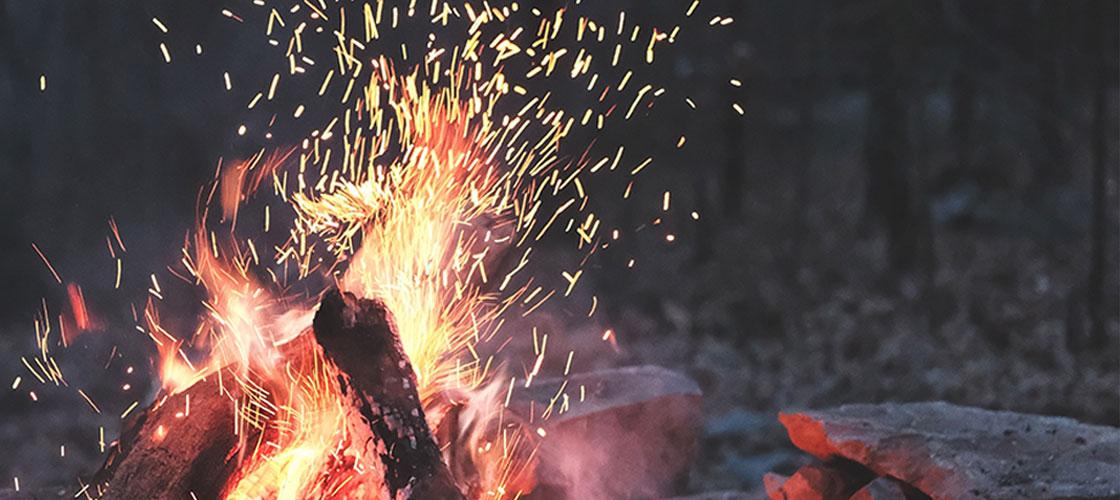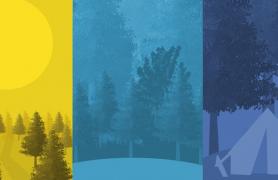
As the stress and struggles of life increase, we long for simpler times and happier moments. Nostalgia, or a sentimental longing and affection for days gone by when we felt happy, has been shown to counteract anxiety, loneliness, and boredom.
For many of us, we are nostalgic about nature because it’s how we spent time as a kid. We jumped in puddles, shared stories around campfires, and chased fireflies on summer nights. We dug up worms for fishing and spotted squirrels for hunting. We came inside smelling like fresh air and pure happiness.
But then we grew up. We got greater responsibilities and bigger dreams, and both, unfortunately, came with less free time. Sometimes we juggle so many projects and priorities that days — maybe weeks — go by before we even look outside, much less go out to play. We are burned out, stressed out, and scheduled out. We inch along like this, year after year, even though we desperately need an intervention.
What if nature is the answer? Nature has all the “cares” perfectly packaged together — self-care, family-care, team-care, and community-care. We are the only missing piece. We need to reconnect to nature just as much as nature needs us to care and conserve it.
In Greek, nostalgia is derived from the compound word that means homecoming. It’s like nature is welcoming us home again after a long, hard season. Even with schedules getting back to normal and packed full already, nature wants you to stay connected and to never lose touch. This is your guide to experiencing nature, including fresh air and pure happiness (we hope!), with wonderful memories for the making. Take a deep breath and enjoy.
Health Benefits of Nature
Reaping the benefits of nature can be as easy as spending time in your own backyard. MDC recommends taking a dose of nature at least once a day to refresh and de-stress. Here are five ways it helps:
- Exposure to nature reduces blood pressure, heart rate, muscle tension, and the production of stress hormones.
- Spending time in nature, conservation areas, woods, backyards, and urban parks may ease stress levels.
- Getting away from busy schedules allows people to connect with nature and themselves in a way that brings calm and a sense of well-being.
- Feeling tired? Spending just 20 minutes outside can give your brain an energy boost comparable to a cup of coffee.
- Taking a nature walk may increase attention spans and creative problem-solving skills by as much as 50 percent.
Ideas for how to connect:
Connect with the outdoors by planting native plants, reading a book in a hammock, or hanging a hummingbird feeder. Enjoy nature at a park by having a picnic, throwing a frisbee with some pals, or simply by getting in some steps with your four-legged friend.
Capture The Memories
Unless you’re a professional photographer, there’s a good chance your camera gear is limited to a smartphone. But that won’t prevent you from capturing great outdoor moments. MDC nature photographer David Stonner offers these helpful tips for how to use your phone’s camera to capture memories.
- Find the right light. You can really enhance the quality of your pictures if you can get the right light. The golden hour is right around sunrise or sunset when the light drops real low in the sky. Everything starts to glow and the shadows aren’t as harsh. So searching out the right light and interesting angle on your subject is far more important than whatever equipment you’re using.
- Pay attention to the background. Even I accidentally mess up now and then, where I have a tree branch coming out of somebody’s head, or power lines going through the middle of my picture. I was so focused on the flower or the furry animal that I failed to pay attention to everything else. Little details like that can make a difference.
- Keep your distance from wildlife. When I’m hiking with a normal lens that doesn’t have an extensive zoom, in the spirit of keeping my distance, I’ll try and just make an environmental picture with the animal as a focal point within the broader landscape. And sometimes those are more impactful and effective than just the portrait. Which proves that you don’t always need long lenses to get wildlife pictures.
- Remember the rule of thirds. Take the camera frame and divide it into thirds horizontally and vertically, so you end up with nine squares. If you can put the subject at the intersection of two of those lines rather than right in the center, it tends to enhance the dynamic feel of the photograph. Details like that can help enhance the unspoken feeling of how the image affects you.
Hang Out In Nature
Hammocking can reduce stress, improve sleep (nap time!), and improve your focus. It’s also a great activity for any age. The gear is simple and easy to set up, and you can hammock almost anywhere — even in your own backyard.
Here's a few tips for hanging out:
- Pick the right place. Check to make sure hammocking is allowed, if in a park or public area.
- Set up at least 200 feet away from any water source, and be mindful of leave no trace principles.
- Select healthy trees at least 6 inches in diameter, with no dead branches or wildlife to disturb, and use nylon/polyester tree-saver straps to hang your hammock.
- Secure your hammock about a 30-degree angle between the strap and ground, having the bottom of the hammock about 18-inches off the ground.
- Listen to nature sounds around you, or your favorite music playlist, to help you relax. Reading and sleeping are also great hammock activities.
Take a Nature Bath
The Japanese have been practicing shinrin-yoku or forest bathing since the 1980s. No, we are not asking you to get naked in the woods. It’s more about simply unplugging and breathing in the natural world around you.
Forest bathing doesn’t necessarily take a forest. Even a small patch of woods or local park will do. The key is to find a quiet spot to yourself. Silence your phone, find a comfortable place to sit if you like, and take some slow, deep breaths. Clear your mind of distractions and use all your senses to take in the sounds, smells, and sights of nature — everything from the daylight streaming through the trees to velvety moss on rocks and the chatter of birds and other wildlife. Relax and let nature wash over you.
When you’re out spending time in nature, chances are you might need a snack. Customize the trail mix of your dreams to conquer those mid-hike munchies with the ingredients below.
Salty and Crunchy
- Nuts such as peanuts, almonds, cashews,pistachios, or pecans
- Seeds such as pumpkin or sunflower seeds
- Banana chips
- Mini pretzels, sesame sticks, or cheese-flavored crackers
- Granola or oat, rice, or wheat cereal
- Mini graham crackers
Sweet and Chewy
- Dried berries such as cranberries, cherries, or blueberries
- Dried fruit such as raisins, apples, pineapples, papaya, or mangoes
- Candy-coated milk chocolates or peanut butter candy
- Butterscotch or chocolate chips (white, dark, or milk chocolate)
- Mini marshmallows
- Yogurt-covered raisins or peanuts
Give Back
Nature needs to be cared for to keep it thriving. The good thing is there are many ways to contribute to the conservation community. Here are just a few ideas to get you started:
- Find a local Stream Team. Volunteers can monitor water quality, stabilize stream banks, and plant streamside trees.
- Participate in a bird count. Experienced birders can become citizen scientists by helping with the National Audubon Society’s annual Christmas bird counts.
- Plant natives. Native plants are a food source for bees, butterflies, and other pollinators.
Title
Biking Tips
Biking is a great way to get your daily dose of nature. Make sure to watch out for tree roots, branches, and
other cyclists when riding.
Before you go
- Carry water
- Wear a helmet
- Check the weather before heading out
- Carry ID
Check out these areas with your bike:
- The Urban Trail (15.8 miles)
- Rock Island Spur (52.5 miles)
- Katy Trail State Park (239.6 miles)
- MKT Nature and Fitness Trail (9.3 miles)
- Frisco Highline Trail (37.6 miles)
- Ruby Jack Trail (16 miles)
- Wolf Creek Trail (10.7 miles)
- Cape LaCroix Recreation Trail (4.4 miles)
- Great Rivers Greenway (128 miles)
Learn more about bicycling on MDC areas at short.mdc.mo.gov/Zr9.
Title
Hiking Tips
Hiking is a great way to get out and discover nature. It can be enjoyed by people of all ages and ability levels.
How to prepare
- Wear comfortable shoes
- Plan to layer your clothing
- Pack water and a light snack
Bring
- Camera and binoculars
- Guides to identify birds, tracks, and wildflowers
- Family and friends
CHECK OUT HIKING OPPORTUNITIES AT:
- Busiek State Forest and Wildlife Area (18 miles of hiking trails)
- Bethany Falls Trail at Burr Oak Woods Nature Center (1.33 mile hiking trail)
- Engelmann Woods Natural Area (1.5 mile hiking trail)
- Millstream Gardens Conservation Area (2 miles of hiking trails)
- Peck Ranch Conservation Area (2.5 mile section of the Ozark Trail)
- Runge Conservation Nature Center (2.4 miles of hiking trails)
- Big Creek Conservation Area (0.7 mile hiking trail)
Find more places to hike.
Title
Wildlife Watching Tips
Wildlife viewing in Missouri can be done anywhere from your backyard to a conservation area. See if you can identify these Missouri wildlife when you’re out exploring. Because you won’t see ALL of these amazing creatures in one place, you’ll just have to get back out in nature again and again. Follow these tips for even greater success.
Keep your distance
Wild animals are wild, and safety is always the first priority.
Binoculars help
Choose binoculars that can be adjusted and also have central focusing to adjust for various distances.
Take a guide
If you’re out birding, a trusty bird field guide is a must. Check out a few field guides from your local library and see which works best for you.
ID what you see
Check out our online field guide to help identify other Missouri wildlife.














Also In This Issue

Hiking! Fishing! Camping! Bigfoot? Adventure awaits at one of Missouri’s more than 1,000 conservation areas.
And More...
This Issue's Staff
Editor - Angie Daly Morfeld
Associate Editor - Larry Archer
Photography Editor - Cliff White
Staff Writer - Bonnie Chasteen
Staff Writer - Kristie Hilgedick
Staff Writer - Joe Jerek
Designer - Shawn Carey
Designer - Marci Porter
Photographer - Noppadol Paothong
Photographer - David Stonner
Circulation - Laura Scheuler






















